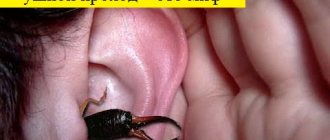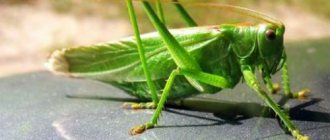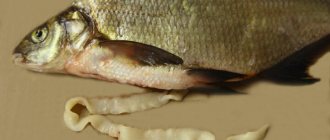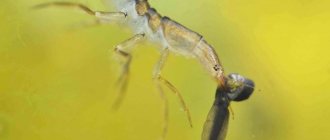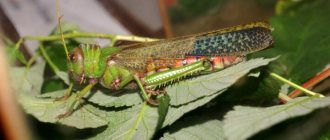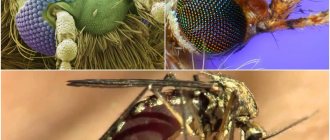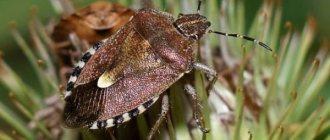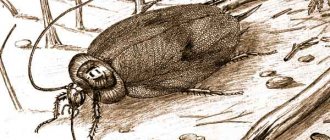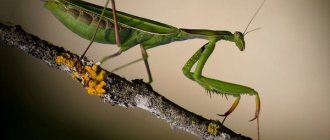Modifications of the oral apparatus
In different groups of insects, the oral apparatus has been modified to better absorb different types of food in different ways. The most specialized and varied types of mouthparts are listed below; they are chosen to demonstrate the richness of the forms assumed by homologous parts and the different ways in which they are used. There are also many other types, and they often represent transitional stages between the types we are considering here. [4]
The type of mouthparts is a systematic character at the order level. In smaller taxa, there are usually no differences in this character: as a rule, only some individual structural features are found. [2]
Gnawing mouthparts
Gnawing mouthparts
Designed for tearing and absorbing more or less solid food. Examples: cockroaches, locusts, grasshoppers, beetles, horntails, sawflies, ants. Some insects that lost such oral apparatus in the adult stage retained it in the larval stage (for example, butterfly caterpillars).
Labrum
Upper lip (labrum). A movable plate that covers other oral organs on top.
Mandibles
Upper jaws, mandibles or mandibles (mandibulae). Solid undifferentiated formations. Predators are armed from the inside with strong and sharp teeth, usually elongated. Herbivorous species have wider mandibles. In social insects they serve for defense and attack and are especially highly developed in the soldier caste (ants, termites).
Ant mandibles
Maxillae
Lower jaws (Maxilla, maxillae). In the original generalized type they consist of 5 parts: cardo, stipes, galea, lacinia, palps (of 5 segments).
Labium
The lower lip (labium) is the second pair of lower jaws fused together. In the original generalized type they consist of 5 parts: chin (postmentum = submentum + mentum), prementum, palps, glossae, paraglossae. Glossae and paraglossae form the apical part of the lower lip, called the ligula or uvula.
Hypopharynx
Subpharynx, or hypopharynx (hypopharynx). It is located under the pharynx and divides the preoral cavity into two sections: anterior and posterior. In the anterior section (cibarium) the oral opening opens. The excretory opening of the salivary glands flows into the posterior section (salivarium).
Gnawing-licking mouthparts [ edit | edit code]
Characteristic of stinging hymenoptera that visit flowering plants to consume nectar. Examples: bees, bumblebees, wasps. Their upper jaws and upper lip are designed in the same way as in the gnawing mouthparts. They use their mandibles to capture prey (wasps) and dig nests in the ground (sand wasps), form pieces of wax (bees) or other materials to build their nests (paper wasps). The maxillae and lower lip have developed into a long retractable organ (usually called the ligule), which serves to penetrate deep into the flower and suck out nectar from there.
Sucking mouthparts
1 – Structure diagram 2 – Mouthparts of a butterfly
Designations in both pictures: VG - upper lip, NG - lower lip, LF - lower jaws (proboscis).
Gnawing type functions
The gnawing oral apparatus serves its owner not only as an effective organ of nutrition , but also as a means of protection from predators and trespassers: the antagonist muscles that move the mandibles apart in the horizontal plane have remarkable strength, because it is with the help of them that ants can hold objects of several thousand times heavier than yourself. Such a bite is not dangerous (if the beetle does not have poisonous glands), however, it is quite painful and can distract the enemy for a short time, giving the beetle the opportunity to escape unharmed.
The food of beetles with a gnawing type of structure often
becomes smaller beetles and (examples of such predators are ground beetles, ladybugs), parts of plants or the entire plant (many species of caterpillars, grasshoppers, locusts). Polite or paper wasps use their mandibles to tear off small sections of bark and old wood from dry stumps, then “chew” them, thoroughly mixing them with sticky saliva and turning them into a kind of sticky papery mass that is quite strong and hard when dry. The nest will subsequently be built from it.
The structure of the oral apparatus varies greatly among different beetles due to dietary preferences, habitat, size of the beetle and its place in the ecological niche. However, the above general scheme will be true for any beetle.
Licking mouthparts
Tahina
A special modification is the muscoid type of oral apparatus, which arose in flies and is adapted to the consumption of both liquid and solid food. The mandibles and maxillae are reduced, and the remaining organs are transformed into a proboscis. Developed in non-blood-sucking flies, including the housefly.
Representatives
Due to the fact that this structure of the mouthparts is characteristic of many orders of the Fly family (Musca), the licking mouthparts are also called muscoid.
Piercing-sucking mouthparts
Developed in insects for the consumption of liquid food, which need to pierce the food substrate for this. Examples: bugs (bed bugs, water striders), homoptera (aphids, cicadas, scale insects and scale insects), mosquitoes, lice, fleas, thrips, etc.
Green locust, description
During their life, locusts go through three stages of development. 1. Egg; 2. Larva; 3. Adult. The hotter the climate, the more often mating occurs, and, consequently, reproduction.
In the autumn, eggs are laid, which are kept in a special bag that protects them from damage. One such pouch can hide more than 100 eggs.
With the onset of spring, the baby locusts hatch, but they do not yet look like adults; they do not have wings.
It takes 40 days and several molts for locusts to move to the next stage.
One flock can contain more than one billion individuals, and the area that the flock occupies reaches 1000 square kilometers. Such a number of insects can produce a sound similar to thunder.
Currently, there are a huge number of locust species, photos of which you can see below.
Locust and grasshopper differences
Let's find out the difference between a locust and a grasshopper:
- The grasshopper's whiskers are longer than those of the locust
and rise strongly above the head; - Nature has awarded the grasshopper with longer limbs
and massive hind legs - it is better adapted for jumping.
Despite their external similarity, these two insects belong to different orders.
– grasshoppers and locusts. The former are representatives of the long-whiskered suborder; the locust belongs to the short-whiskered suborder.
There are also differences in the lifestyle of the grasshopper and the locust:
- short mustaches are herbivores
, and representatives of grasshoppers are predators; - locusts are diurnal
, raiding crops in broad daylight; long-legged jumpers are considered nocturnal insects; - grasshoppers lay eggs on the ground parts of plants
, and locust pests lay eggs in the soil.
Favorable conditions
Locusts belong to the family of true locusts ( Acrididae
) from the suborder Orthoptera.
When there is an abundance of food, it leads a solitary lifestyle, but under certain conditions (usually when there is a lack of food in hot, dry years) it begins to reproduce so intensively that too much of it accumulates in one place. Some generations die from lack of food, while others flock together.
Due to the conflict with the “neighbors,” the hormonal balance of the locust changes. The nymphs acquire not a green, protective color, but a black and yellow color and go in search of new sources of food.
Gradually the flock grows - more and more individuals join it. Individual members of the flock obey the movements of their closest neighbors.
When the number of insects becomes high enough, the flock turns into a well-coordinated squad, moving in a single stream. Thus begins the invasion.
During the “march,” the nymphs molt and turn into winged, sexually mature individuals. Usually the flock moves during the daytime. As darkness falls, insects land and begin to consume food.
There are only a few types of terrain that are immune to locust infestations. So, she does not fly in the rain and stays away from the jungle - she does not like the leaves of tropical trees.
Locusts can climb to a height of about 2000 m, but not higher - it is too cold there, so the swarm cannot overcome mountain ranges.
Migratory locusts do not always form swarms. Usually she leads the lifestyle of a harmless “grasshopper”.
There are billions of locusts in one swarm. They usually appear after dark, and by morning there is nothing left of the crops.
One locust eats only 2g of food per day, but a swarm of a billion insects consumes 200 tons!
Insect diet
For the most part, locusts spend their time on leaves, flowers, and grass. Locusts are the most vegetarians without any obvious food preferences. Most species do not care what kind of crop it is - wild or agricultural.
They feed on the leaves of plants, trees, shrubs, and all ground parts of plantings. Only some species prefer herbaceous plants.
During its life, an insect eats an average of 300-350 g of plant mass, and the daily volume is twice its own weight.
When insects gather in swarms, what the locusts feed on depends on the objects that come across its path. In this case, even thatched roofs and reeds, not to mention vegetables, grains, and melons, can be eaten. As eyewitnesses say, during insect attacks, locusts only devour bricks and iron.
The difference between a locust and a grasshopper
The main difference between grasshoppers and locusts is that they belong to different families and suborders. Unlike locusts, the grasshopper belongs to the long-whiskered suborder.
The structure of the paws also differs. The locust's are shorter than the grasshopper's.
Locusts are active during the day, while grasshoppers are active at night.
For agriculture, grasshoppers are harmless, but locusts often cause colossal harm and huge losses.
These insects also differ in the way they lay eggs. Locusts lay eggs in the soil, and grasshoppers use plant stems for their offspring or lay eggs under the bark of trees.
Phases of development
As has already been noted, locusts have two development options: solitary and gregarious, which are strikingly different from each other.
Single cycle
The locust filly, as single individuals are called, develops freely with an abundance of food and leads an inactive, shy lifestyle, which is why it was previously systematized as a separate species. Single individuals are characterized by camouflage coloration and pronounced sexual dimorphism. The filly does not cause significant harm.
In fact, a single phase of locust development is necessary for the preservation of the population. The female lays eggs and when the food supply becomes insufficient to feed all the larvae, the locust moves on to another stage of development.
Herd development
Association in swarms is observed in hot, dry years, when locusts begin to experience a shortage of food and moisture. According to recent studies, a lack of protein provokes females to intensively lay so-called “campaign” offspring.
Gathering into a large tribe, intense friction against each other, the visibility of their own kind, the smell of fellow tribesmen causes a powerful production of serotonin in the nervous system.
Due to the release of the hormone, individuals literally undergo dramatic morphological changes in a matter of hours:
- change of color;
- increase in size;
- leveling sexual dimorphism.
Clusters of adult flying locusts are called swarms; the larvae form swarms. The population moves, as if on command, in one direction. Weakened individuals are eaten along the way by their fellow tribesmen. Adult locusts are capable of long flights and cover from 90 to 140 km per day.
The locust invasion cannot go unnoticed. The sound of approaching insects is comparable to the sound of thunder, and the flock itself covers the sun.
On its way, the flock devours literally everything, even the thatched roofs of houses, vineyards, orchards, vegetable and grain plantations.
Just decades ago, locust attacks caused famine. Now the flocks are causing colossal losses to farmers.
In 2015, a locust invasion in Russia destroyed an area comparable to the territory of an entire state, for example, Romania.
How does the oral apparatus work?
The locust's mouthparts are gnawing
, it is intended for feeding solid foods. This type is the original one, and from it other forms of mouth structure in other insects arise. The gnawing apparatus contains the most complete set of elements - the upper and lower lips, and two pairs of upper and lower jaws.
Using the upper lip, the insect determines the suitability of the item being eaten. The upper jaws move in a horizontal plane
, bite off a small piece and grind it into smaller pieces.
Strongly mobile lower jaws push crushed food into the esophagus
.
In addition to the feeding function, the upper and lower jaws can be used by insects for protection in battle with the enemy.
General characteristics of the pest
Locust sizes vary from 3 to 7 cm. Females are larger than males. The body is oblong, attached to it are rigid elytra and a pair of translucent wings, which remain invisible when folded. The color is very variable and depends on the age, conditions and lifestyle that the locust leads:
- Even individuals emerging from the same oviposition may differ in coloring.
- What a locust looks like is also determined by the phase of its development.
- In the European zone, single individuals are predominantly yellow, brick, green, olive, brown in color, which helps to camouflage against the background of the surrounding vegetation.
- The older the individual, the darker its color becomes.
- If the locust joins the swarm, it acquires the same color as the rest of the team members.
The locust belongs to the order Orthoptera of the locust family.
The large head is not particularly mobile. Large crescent-shaped eyes and a rectangular, almost square muzzle of the locust give the insect a good-natured appearance. The gnawing mouthparts are represented by powerful jaws that help gnaw through even the thickest and most durable stems. The insect gnaws leaves with its upper mandibles, and only then crushes them using its lower mandibles.
The pinkish hind legs are well developed, which allows the locust to jump at a distance of 20 times its length. It is no coincidence that insects are endowed with jumping abilities. In the larval stage, they still cannot fly and their motor capabilities are limited to crawling and jumping. Some species do not exhibit flight activity even as adults.
How long locusts live depends on environmental conditions. Rainy seasons provoke the development of fungal plant diseases, which leads to insect infection and death.
Natural enemies: wild wasps, beetles, birds can also shorten life expectancy. Humans also make their contribution by destroying pests.
If the locust is in optimal conditions and has not become anyone’s victim, then it can live from 8 months to 2 years, depending on the species.
Do locusts bite?
Very often it is confused with grasshoppers. Although they have a similar appearance, they also have fundamental differences:
- The grasshopper has long whiskers that help it find prey (the locust has short whiskers);
- The grasshopper leads a predominantly nocturnal lifestyle (the locust is a day resident).
Since the grasshopper is a predator, it is he who can bite a person quite painfully, very often to the point of bleeding, with the introduction of a burning composition into the wound.
Do locusts have teeth? has no teeth in its mouthparts
- it is a herbivore, not a carnivore. She will not specifically attack a person and try to harm him.
However, the jaws have quite a lot of strength
necessary for quickly gnawing off pieces from hard plants. And when the self-preservation instinct is triggered, the pest can sensitively “pinch” the skin. If this happens, it is recommended to treat the bite site with hydrogen peroxide and iodine.
The locust also cannot sting - it does not have a sting provided by nature.
This is a huge disaster for all farmers and gardeners. It moves in large flocks, quickly and feeds on any vegetation that is available to it.
Not only crops can be destroyed, but also trees, shrubs, reed and thatched roofs, and wooden furniture. Locusts have gnawing mouthparts designed for biting and grinding solid food. She cannot bite or sting.
What kind of mouthparts do butterflies have?
Butterflies are delicate and beautiful creatures. We often see them sitting on flowers. To feed nectar, a tube-shaped apparatus is needed. These insects do not chew anything. The type of mouthparts of the butterfly is tubular-sucking.
Representatives of the order Lepidoptera
Lepidoptera, or Lepidoptera (from the merger of the words “wing” and “scale” in ancient Greek) is an order of insects distinguished by a dense covering of hair-scales on the wings. Most often they are simply called butterflies, moths or moths.
Archaeologists have found remains proving that butterflies existed during the Jurassic period.
Fossilized remains of a butterfly from the Jurassic period
In everyday life, they use a division into lower and higher butterflies, where the lower are micro-lepidoptera, primitive butterflies, and the higher are macro-lepidoptera day and night butterflies.
Separately, it is worth mentioning how to distinguish daytime from nocturnal insects, with the exception of their lifestyle.
- Day butterfly. When resting, folds its wings flat over its back. More brightly colored than night.
- Moth. In a calm state, it keeps its wings open, partially or completely masking its body. The ratio of body length to wing length is greater than that of diurnal individuals. The antennae are also thicker and more branched.
As for etymology, the Russian name “butterfly” comes from the Old Slavonic “grandmother”. Pagans believed that the souls of dead relatives visited the living, reincarnating as insects. To this day you can hear Old Believers in villages and villages calling them “babuchka”, “grandmother”.
The familiar “moth” is also derived from the Old Slavonic words “to dangle”, “revenge”, which means “to spin around its axis” or “to mix in jerks”.
The word “moth”, according to one version, is derived from the Old Slavonic “grind” meaning “to destroy.” According to another, from the Irish mil meaning “small animal”.
General characteristics of Lepidoptera
Lepidoptera are one of the most numerous orders of insects belonging to the phylum arthropods. A characteristic feature of all representatives of the order is four wings covered with a fine layer of modified scales. Their coloring creates bizarre and unique patterns on the surface.
Butterfly wing under a microscope
If we draw an analogy with other insects, then butterflies are a rather “young” group. The first representatives appeared with the flowering plants in the Cretaceous period.
Butterflies are distributed throughout the world, right up to the border of permafrost. Those species that live in temperate latitudes need wintering. More often, the insect survives the cold period in the form of a pupa, less often - in the adult stage. In the latter case, lepidoptera can migrate over vast distances, gathering in huge flocks.
Monarch Butterfly Migration
More than 15,000 species of butterflies are found in the CIS countries.
Common to our latitudes, urticaria, mourning grass, peacock's eye and buckthorn are able to survive the winter as adults without leaving their native lands. When spring comes, they will be ready to reproduce again.
The butterfly's two faceted eyes are capable of recognizing colors, but unlike humans, they see the world in the ultraviolet part of the spectrum. This feature allows zoologists to control the behavior of flying insects using special lamps and conduct observations at night.
How a butterfly sees the world
Butterflies are an important part of the ecosystem, since many plants are pollinated mainly or only by them. Caterpillars serve as food for many small animals and birds.
There is also a downside - the voracious larvae of butterflies can cause significant damage to vegetable crops and plants used by humans. In some cases, they can leave entire gardens and even forests without leaves.
Types of lepidopteran insects
Zoologists have recorded more than 158 thousand species, subspecies and families of these flying insects.
Lepidopterist entomologists study the butterfly order.
Since the scientific classification system is constantly modified and adjusted, the most understandable is considered to be the one in which all lepidopteran insects are divided into four suborders:
- primary toothed moths;
- trunkless;
- proboscis;
- heterobatmy.
This classification is used by butterfly collectors (lepidopterophilists). Let's look at each suborder in a little more detail.
Toothed moths
The smallest lepidopteran representatives of the species that existed back in the time of dinosaurs. The size of the insect varies from 4 to 15 mm. The gnawing type oral apparatus consists of asymmetrical mandibles, where the upper jaw predominates over the lower jaw. A distinctive feature is the long and large antennae, the size of which is approximately 75% of the size of the wings.
This subgroup includes about 160 species of butterflies. The most famous representatives are Micropteryx calthella.
Small wing of the family Micropteryx calthella
Proboscis
Officially, this species appeared in the systematization of lepidopteran insects relatively recently - in 1967. Until this time, all proboscis moths were classified as toothed moths.
This is the smallest subgroup, which includes only butterflies of the Heterobathmiidae family.
Mourning moth butterfly
What do locusts eat?
When forming a huge flock, the insect can eat all the vegetation that may be encountered on its way. The total weight of plants eaten per day is equal to the pest’s own weight, but an average flock destroys 3-4 tons of greenery every day .
In addition, the diet expands over the years - the older the insect, the more omnivorous it becomes .
- Reed and reed thickets along the banks of rivers, ponds, lakes, swamps;
- Any cereal crops - wheat, oats, corn, rye, barley, millet, sorghum and others. With less appetite, the insect destroys flax, buckwheat, and hemp;
- Vegetable crops - beans, beans, soybeans, table and sugar beets, potatoes and others;
The structure of the mouthparts of beetles
The head of a beetle, and in particular the mouthparts, consists of several components:
- Upper lip;
- Underlip;
- Gnawing organs;
- Palpi;
The upper lip is called the labrum and is a fold of skin that covers the oral apparatus at rest. It contains many sensitive taste and tactile receptors. With their help, the insect determines whether objects are edible. Underneath it lie the chewing organs—mandibles and maxillae (upper and lower jaws, respectively).
Their number is equal, that is, how many mandibles a beetle has, so many maxillae. They contain serrated processes that help the jaws grab prey, tear small pieces from it and grind them as long as it takes until they get manageable pieces. Then the food is ground and, with the help of maxil and labium, carried deeper into the mouth, as close to the esophagus as possible.
Palps of different types located on the head (labial, maxillary and others) provide the beetle with the necessary information about what is happening in the world around it, since most insects have rather poor vision. The palps are capable of detecting the odors of potential partners or danger, air vibrations, temperature changes, they can also work as an organ of touch, examining an unfamiliar substrate or food.
general information
The structure of all beetles, of course, varies, but in general terms it can always be described. Most beetles have a separate head, which most likely contains antennae, eyes and mouthparts. Behind the head is the next part of the body - the chest. It is less mobile relative to the head. The first and second pairs of legs are located on the chest.
Between the sections of the abdomen and chest there are wings.
, which has the function of protecting against external damage. These wings often develop in beetles during the pupal stage, forming from initial tissues. Many people are often interested in the question: “How many wings does a beetle have?” Beetles can have no more than two wings, that is, no more than one pair.
The mechanism of operation of the fly's mouthparts
Flies feed mainly on liquid nutrient substrates and finely dispersed food suspensions, for example, products of decomposition of organic residues. The liquid is absorbed by the proboscis, entering the food canal through thin capillary tubes on the surface of the lower lip.
Some types of solid food, such as sugar, are also consumed by flies using this proboscis. This is done as follows: first, the fly secretes a drop of saliva onto the surface of the food, which partially dissolves and is then absorbed into the mouth as a liquid.
Appearance and internal structure
At first glance, the body structure of a fly seems simple, but in fact, many institutes have been studying these insects for a long time. The body of a fly consists of three parts: head, thorax and abdomen. The lower part of the head has a yellow tint. The following organs are located on it:
- Eyes. In the fly they are quite large and consist of many small simple eyes that form a faceted network. The image obtained using facets has the appearance of a mosaic.
- Oral apparatus. Insects have powerful jaws and a proboscis. Food enters through the lobes of the upper and lower lips. A large number of tubules connect at the central point of the proboscis. In species that feed on blood, the structure of the oral apparatus contains sharp plates with which the insect pierces the skin of the prey.
- Mustache. This organ helps to navigate in space and smell. The antennae of females and males may differ.
The chest has three segments, the second segment being the most developed. On the chest there are 3 pairs of limbs, which consist of 5 segments. The legs of flies are equipped with developed muscles, claws and suckers. When the fly walks, the pads of its feet secrete a sticky liquid. The paws perform another function - they analyze the quality and taste of food.
The front pair of wings is well developed, has a membranous structure, the hind wings are deformed and form halteres. With the help of these appendages, the fly can hover in the air and maintain balance.
The cylindrical abdomen consists of 10 segments. The chitinous shell of flies tends to stretch when saturated and during pregnancy.
The most important internal organs are located in the abdomen. The reproductive system is represented by ducts, accessory glands, as well as eggs or testes, depending on the gender of the individual. External appendages differ from species to species.
Females lay clutches of eggs; their number per clutch can range from 70 to 150, depending on the species. In the family of corpse flies there are viviparous ones.
The digestive system is represented by the goiter, intestines, Malpighian vessels and excretory tubules. Food is digested before absorption; for this, the insect introduces a special digestive secretion into it.
The respiratory organs include a large number of tracheae, which are distributed throughout the body. Their opening to the outside is ensured by spiracles.
The brain is made up of many neurons. The circulatory system includes the heart, aorta, pterygoid muscle and dorsal vessel. Blood is colorless and transports nutrients.
Head structure
The individual parts of the fly's head have their own names:
- forehead - located between the eyes, at the top it turns into the crown, at the bottom of it there are antennae;
- the fly's face is located below the whiskers and looks like a facial plate bounded by the forehead and frontogenal suture;
- there are cheeks under the eyes;
- the back surface of the head is convex or flat (in some species it is concave);
- the eyes are convex faceted, formed from many facets; in males and females the facets are different - in the former they are holaptic and very close together; eye color varies between species;
- in the oral cavity there is a proboscis instead of the lower lip with sucking lobules at the end, here the salivary gland channel passes;
- The fly's jaws (upper and 1 pair of lower) are atrophied.
The organs of smell and taste are much more advanced and subtle compared to humans. The sharpness and their cricketing ability are associated with a large number of “nostrils,” although the olfactory organs are separated from the respiratory organs and are located on the antennae; some species of dipterans also sense taste with their paws, or rather, with their last segments on the legs.
But the ears of a fly are receptors - nerve cells that respond to external stimuli (sounds, temperature, light, vibration, etc.).
The structure of a fly's head
Important!
The structure of a fly's eyes is unique and has served as a model for scientists to make discoveries. Huge spherical organs of vision consist of several thousand facets, similar to spyglasses. Each of them sees a certain piece of the surrounding world, and its image is then transmitted to the brain and puts together a “overall picture” from the mosaic. Thus, the fly has a full 360° view and quickly reacts to any movement around it.
Locust diet and preferences
When an insect gathers in huge swarms of millions, this herd destroys several tons of vegetation per day. And the mass of what one individual eats is equal to its own weight. Everything that comes in the way is used. Moreover, the older the locust, the more disorderly its menu:
- Thickets of reeds and reeds on the banks of reservoirs.
- Any crops.
- Cotton, flax fields.
- Vegetable plantings.
- Potato fields and sugar cane.
- Melon crops and orchards.
- Sunflower fields.
- Forests, groves, shrubs.
If a locust invasion passes through populated areas, then local residents are easily left without thatched roofs, wooden fences, furniture, etc.
